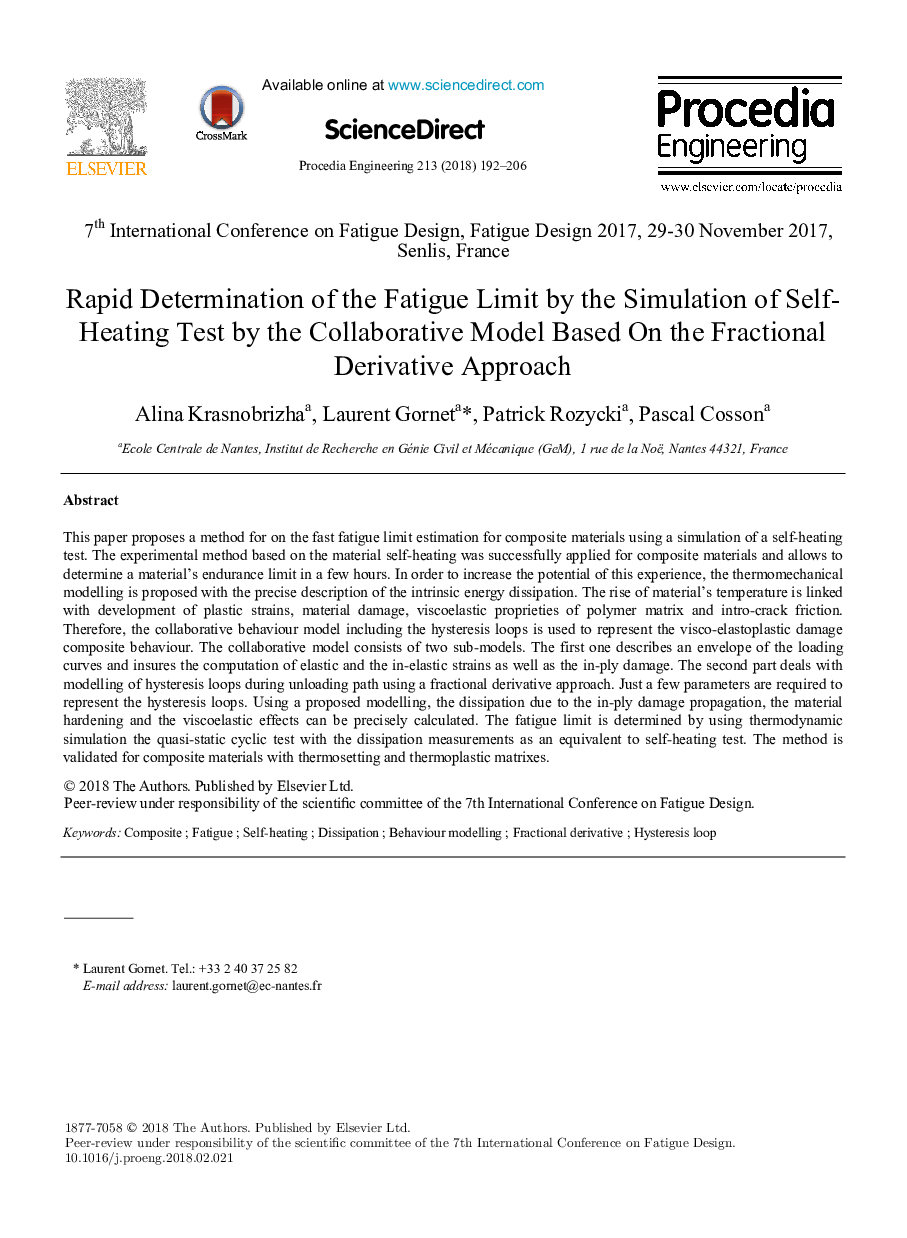| کد مقاله | کد نشریه | سال انتشار | مقاله انگلیسی | نسخه تمام متن |
|---|---|---|---|---|
| 7225506 | 1470610 | 2018 | 15 صفحه PDF | دانلود رایگان |
عنوان انگلیسی مقاله ISI
Rapid Determination of the Fatigue Limit by the Simulation of Self-Heating Test by the Collaborative Model Based On the Fractional Derivative Approach
ترجمه فارسی عنوان
تعیین سریع حدت خستگی با استفاده از شبیه سازی آزمایش خود گرمایش با استفاده از مدل همکاری بر مبنای روش مشتق مفرط
دانلود مقاله + سفارش ترجمه
دانلود مقاله ISI انگلیسی
رایگان برای ایرانیان
کلمات کلیدی
کامپوزیت، خستگی، خود حرارت، جدایی، مدل سازی رفتار، مشتق مکرر، حلقه پسماند،
ترجمه چکیده
در این مقاله روشی برای تخمین حد پایین خستگی برای مواد کامپوزیتی با استفاده از شبیه سازی آزمون خود گرمایی ارائه شده است. روش آزمایشی بر مبنای حرارت دادن مواد به صورت موفقیت آمیز برای مواد کامپوزیتی مورد استفاده قرار گرفته و اجازه می دهد تا محدودیت استقامتی مواد را در چند ساعت تعیین کند. به منظور افزایش پتانسیل این تجربه، مدل سازی حرارتی مکانیکی با توضیح دقیق از انرژی آزاد درونی پیشنهاد شده است. افزایش درجه حرارت مواد با توسعه سوسیس پلاستیکی، آسیب های مادی، وسائل تخریب پذیری ماتریکس پلیمر و اصطکاک آن در ارتباط است. بنابراین، رفتار رفتار مشترک، شامل حلقه های هیسترزیس، برای نشان دادن رفتار کامپوزیت آسیب پذیری ویسکوزیته الاستوپلاستیک است. مدل مشارکتی شامل دو زیر مدل است. اولین نمونه یک پاکت از منحنی بارگذاری را توصیف می کند و محاسبه کششی های کششی و کششی و همچنین آسیب های درون را تضمین می کند. بخش دوم با مدل سازی حلقه های هیسترزیس در طول مسیر تخلیه با استفاده از یک روش مشتق تقسیم می پردازد. برای نشان دادن حلقه های هیسترزیس فقط چند پارامتر لازم است. با استفاده از یک مدل پیشنهادی، تخلیه به علت انتشار خسارت درونی، سخت شدن مواد و تأثیرات ویسکولاستیک می تواند دقیقا محاسبه شود. حدت خستگی با استفاده از شبیه سازی ترمودینامیکی آزمون تست چرخه شبه استاتیک با اندازه گیری های تخلیه به عنوان معادل تست خود گرمایش تعیین می شود. این روش برای مواد کامپوزیتی با ماتریس های گرماسخت و گرمانرم معتبر است.
موضوعات مرتبط
مهندسی و علوم پایه
سایر رشته های مهندسی
مهندسی (عمومی)
چکیده انگلیسی
This paper proposes a method for on the fast fatigue limit estimation for composite materials using a simulation of a self-heating test. The experimental method based on the material self-heating was successfully applied for composite materials and allows to determine a material's endurance limit in a few hours. In order to increase the potential of this experience, the thermomechanical modelling is proposed with the precise description of the intrinsic energy dissipation. The rise of material's temperature is linked with development of plastic strains, material damage, viscoelastic proprieties of polymer matrix and intro-crack friction. Therefore, the collaborative behaviour model including the hysteresis loops is used to represent the visco-elastoplastic damage composite behaviour. The collaborative model consists of two sub-models. The first one describes an envelope of the loading curves and insures the computation of elastic and the in-elastic strains as well as the in-ply damage. The second part deals with modelling of hysteresis loops during unloading path using a fractional derivative approach. Just a few parameters are required to represent the hysteresis loops. Using a proposed modelling, the dissipation due to the in-ply damage propagation, the material hardening and the viscoelastic effects can be precisely calculated. The fatigue limit is determined by using thermodynamic simulation the quasi-static cyclic test with the dissipation measurements as an equivalent to self-heating test. The method is validated for composite materials with thermosetting and thermoplastic matrixes.
ناشر
Database: Elsevier - ScienceDirect (ساینس دایرکت)
Journal: Procedia Engineering - Volume 213, 2018, Pages 192-206
Journal: Procedia Engineering - Volume 213, 2018, Pages 192-206
نویسندگان
Alina Krasnobrizha, Laurent Gornet, Patrick Rozycki, Pascal Cosson,
